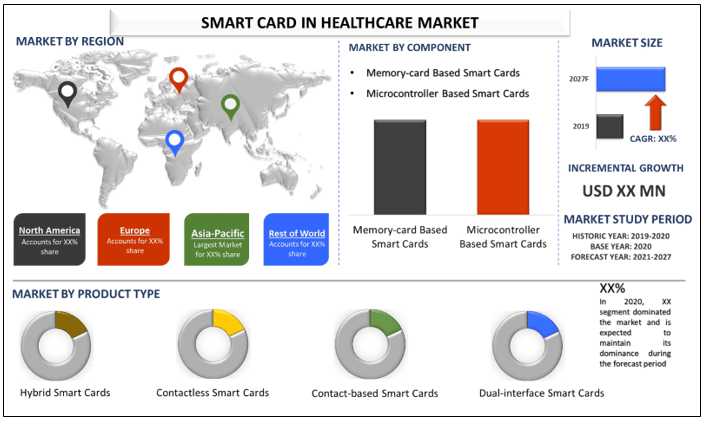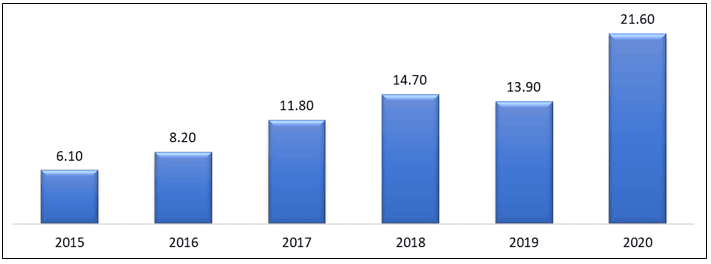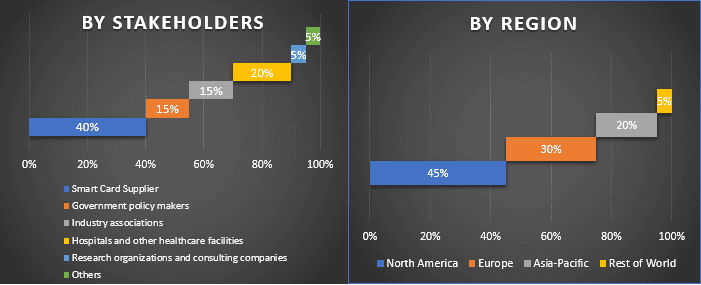- Strona główna
- O nas
- Branża
- Usługi
- Czytanie
- Kontakt
Rynek kart inteligentnych w opiece zdrowotnej: bieżąca analiza i prognoza (2021-2027)
Nacisk na typ produktu (karty inteligentne hybrydowe, karty inteligentne zbliżeniowe, karty inteligentne stykowe i karty inteligentne z podwójnym interfejsem); Komponent (karty inteligentne oparte na kartach pamięci i karty inteligentne oparte na mikrokontrolerach); Region/Kraj

Wartość rynku kart inteligentnych w opiece zdrowotnej szacuje się na około 1,05 miliarda USD w 2020 roku i oczekuje się, że zarejestruje on roczny wzrost na poziomie około 12% w okresie prognozy (2021-2027).Karta inteligentna to niewielki, przenośny komputer, zazwyczaj wielkości karty kredytowej, bez wyświetlacza i klawiatury. Obejmuje on mikroprocesor, pewną pamięć i kilka aplikacji. W postaci kart SIM i kart kredytowych karty inteligentne są najpopularniejszą formą mocy przetwarzania IT na całym świecie. W karcie inteligentnej osadzony jest chip pamięciowy z mocą obliczeniową do obsługi wielu różnych aplikacji w połączeniu z czytnikiem kart inteligentnych. Wzrost liczby zachorowań na Covid-19 zwiększył płatności zbliżeniowe, pozytywnie wpływając na rynek kart inteligentnych w opiece zdrowotnej. W ostatnich czasach interfejs zbliżeniowy stał się głównym wyborem dla rządów i usług finansowych, co zwiększa popyt na karty inteligentne na rynku opieki zdrowotnej. Ponadto, rosnąca digitalizacja systemów opieki zdrowotnej na całym świecie i wykorzystanie kart inteligentnych do przechowywania danych pacjentów, co zapewnia wysoki poziom bezpieczeństwa i prywatności, ma na celu zwiększenie wzrostu rynku. Rosnące nadużywanie świadczeń medycznych i inne oszustwa w branży opieki zdrowotnej rozprzestrzeniły się na całym świecie w ciągu ostatnich kilku lat. Wiele rządów krajowych zwraca się obecnie w kierunku kart inteligentnych w celu uzyskania dokumentacji medycznej osób. Firmy ubezpieczeń zdrowotnych wydają głównie te inteligentne karty zdrowotne w celu lepszej regulacji roszczeń i innych praktyk medycznych. Inteligentne karty zdrowotne zapewniają różne korzyści dla świadczeniodawców usług medycznych, jak i pacjentów, w tym szybszą procedurę przyjęcia do szpitala, ograniczenie oszustw medycznych (nadużywania) i kradzieży tożsamości, zmniejszenie pracy dokumentacyjnej przy prowadzeniu dokumentacji medycznej, zmniejszenie całkowitego kosztu prowadzenia dokumentacji medycznej.
Całkowite finansowanie branży zdrowia cyfrowego na świecie od 2010 do 2020 roku (w miliardach dolarów amerykańskich)

Informacje przedstawione w raporcie
„Wśród typów produktów segment kart inteligentnych zbliżeniowych ma największy udział”
W oparciu o typ produktu, rynek jest podzielony na karty inteligentne hybrydowe, karty inteligentne zbliżeniowe, karty inteligentne stykowe i karty inteligentne z podwójnym interfejsem. Segment kart inteligentnych zbliżeniowych zdominował rynek w 2020 roku i oczekuje się, że będzie rósł lukratywnie w okresie prognozy, ze względu na rosnące przyjęcie kart inteligentnych zbliżeniowych ze względu na ich przewagę nad kartami stykowymi i brak wymogu posiadania czytnika. Działają one przy użyciu częstotliwości radiowych lub technologii Near Field Communication (NFC), która ustanawia bezprzewodową komunikację między kartą inteligentną a miejscem, w którym ma być używana. Karty inteligentne zbliżeniowe składają się z cewki antenowej i chipa mikroprocesorowego, co pozwala im działać szybciej niż karty stykowe. Również odporne na manipulacje przechowywanie danych jest kolejnym czynnikiem napędzającym wzrost segmentu. Ponadto, oczekuje się, że postęp w technologii produktu i rosnąca świadomość wśród społeczeństwa na temat korzyści płynących z kart inteligentnych również zwiększą popyt na segment.
„Wśród komponentów segment kart inteligentnych opartych na mikrokontrolerach ma największy udział”
W oparciu o komponent, rynek jest podzielony na karty inteligentne oparte na kartach pamięci i karty inteligentne oparte na mikrokontrolerach. Segment kart inteligentnych opartych na mikrokontrolerach zdominował rynek w 2020 roku i oczekuje się, że będzie rósł lukratywnie w okresie prognozy. Karty inteligentne oparte na mikrokontrolerach są przenośne i mają dużą pamięć, co ma na celu zwiększenie wzrostu tego segmentu w okresie prognozy. Ponadto, rosnące wykorzystanie kart inteligentnych opartych na mikrokontrolerach w opiece zdrowotnej również napędza wzrost rynku.
„Europa oznacza jeden z największych rynków kart inteligentnych w opiece zdrowotnej”
Dla lepszego zrozumienia adopcji rynku kart inteligentnych w opiece zdrowotnej, rynek jest analizowany na podstawie jego obecności na całym świecie w krajach takich jak Ameryka Północna (Stany Zjednoczone, Kanada i reszta Ameryki Północnej), Europa (Niemcy, Francja, Hiszpania, Wielka Brytania i reszta Europy), Azja i Pacyfik (Chiny, Japonia, Indie, Australia i reszta APAC) i reszta świata. Europa zdominuje rynek kart inteligentnych w opiece zdrowotnej ze względu na rosnące inicjatywy podejmowane przez kilka rządów, jak i organizacje pozarządowe, w celu zapewnienia dobrych warunków opieki zdrowotnej. Europejskie karty ubezpieczenia zdrowotnego są wydawane bezpłatnie mieszkańcom 32 krajów. Wiele krajów europejskich posiada własne krajowe karty identyfikacyjne służby zdrowia. Oczekuje się, że czynniki te zwiększą wzrost rynku. Niektórzy z głównych graczy działających na rynku to Thales Group, IDEMIA, Giesecke + Devrient GmBH, CPI Card Group, HID Global Corporation, Watchdata, Eastcompeace, Inteligensa, ABCorp, CardLogix. Kilka fuzji i przejęć, wraz z partnerstwami, zostało podjętych przez tych graczy w celu zwiększenia ich obecności w różnych regionach.
Powody, dla których warto kupić ten raport:
- Badanie obejmuje analizę rozmiaru rynku i prognoz, zatwierdzoną przez uwierzytelnionych ekspertów z branży
- Raport przedstawia szybki przegląd ogólnych wyników branży na pierwszy rzut oka
- Raport obejmuje dogłębną analizę wybitnych podmiotów z branży, ze szczególnym uwzględnieniem kluczowych danych finansowych firmy, portfolio produktów, strategii ekspansji i ostatnich wydarzeń
- Szczegółowe badanie czynników napędzających, ograniczeń, kluczowych trendów i możliwości występujących w branży
- Badanie kompleksowo obejmuje rynek w różnych segmentach
- Dogłębna analiza na poziomie regionalnym branży
Opcje dostosowywania:
Rynek kart inteligentnych w opiece zdrowotnej może być dodatkowo dostosowany do wymagań lub dowolnego innego segmentu rynku. Poza tym, UMI rozumie, że możesz mieć własne potrzeby biznesowe, dlatego zapraszamy do kontaktu z nami, aby uzyskać raport, który w pełni odpowiada Twoim wymaganiom.
Spis treści
Analiza historycznego rynku, szacowanie obecnego rynku i prognozowanie przyszłego rynku globalnego rynku kart inteligentnych w opiece zdrowotnej były trzema głównymi krokami podjętymi w celu stworzenia i analizy adopcji kart inteligentnych w opiece zdrowotnej. Przeprowadzono wyczerpujące badania wtórne w celu zebrania historycznych danych rynkowych i oszacowania obecnej wielkości rynku. Po drugie, aby zweryfikować te spostrzeżenia, wzięto pod uwagę liczne ustalenia i założenia. Ponadto przeprowadzono wyczerpujące wywiady pierwotne z ekspertami branżowymi w całym łańcuchu wartości sektora kart inteligentnych w opiece zdrowotnej. Po założeniu i walidacji danych rynkowych poprzez wywiady pierwotne, zastosowaliśmy podejście top-down do prognozowania pełnej wielkości rynku. Następnie zastosowano metody podziału rynku i triangulacji danych w celu oszacowania i analizy wielkości rynku segmentów i podsegmentów, do których należy branża. Szczegółowa metodologia jest wyjaśniona poniżej:
Analiza historycznej wielkości rynku
Krok 1: Dogłębne badanie źródeł wtórnych:
Szczegółowe badanie wtórne zostało przeprowadzone w celu uzyskania historycznej wielkości rynku kart inteligentnych w opiece zdrowotnej poprzez wewnętrzne źródła firmy, takie jakraporty roczne i sprawozdania finansowe, prezentacje wyników, komunikaty prasowe itp.oraz źródła zewnętrzne, w tymczasopisma, wiadomości i artykuły, publikacje rządowe, publikacje konkurencji, raporty sektorowe, bazy danych stron trzecich i inne wiarygodne publikacje.
Krok 2: Segmentacja rynku:
Po uzyskaniu historycznej wielkości rynku kart inteligentnych w opiece zdrowotnej, przeprowadziliśmy szczegółową analizę wtórną w celu zebrania historycznych informacji o rynku i udziałów dla różnych segmentów dla głównych regionów. Główne segmenty zawarte w raporcie to typ produktu, komponent i region. Ponadto przeprowadzono analizy na poziomie krajowym w celu oceny ogólnej adopcji kart inteligentnych w opiece zdrowotnej w każdym regionie.
Krok 3: Analiza czynników:
Po uzyskaniu historycznej wielkości rynku różnych segmentów i podsegmentów, przeprowadziliśmy szczegółowąanalizę czynnikóww celu oszacowania obecnej wielkości rynku kart inteligentnych w opiece zdrowotnej. Ponadto przeprowadziliśmy analizę czynników przy użyciu zmiennych zależnych i niezależnych, w tym rosnącego popytu na zaawansowany technologicznie produkt w sektorze opieki zdrowotnej i rosnącego ryzyka prywatności danych itp.
Szacowanie i prognoza bieżącej wielkości rynku
Szacowanie bieżącej wielkości rynku:W oparciu o praktyczne informacje z powyższych 3 kroków, doszliśmy do obecnej wielkości rynku, kluczowych graczy na rynku kart inteligentnych w opiece zdrowotnej i udziałów rynkowych segmentów. Wszystkie wymagane udziały procentowe, podziały i podziały rynku zostały określone przy użyciu wyżej wspomnianego podejścia wtórnego i zostały zweryfikowane za pośrednictwem wywiadów pierwotnych.
Szacowanie i prognozowanie:W celu oszacowania i prognozowania rynku, przypisano wagi do różnych czynników, w tym czynników napędzających i trendów, ograniczeń i możliwości dostępnych dla interesariuszy. Po przeanalizowaniu tych czynników zastosowano odpowiednie techniki prognozowania, tj. podejście top-down, aby dojść do prognozy rynkowej około 2027 roku dla różnych segmentów i podsegmentów na głównych rynkach na całym świecie. Metodologia badawcza przyjęta do oszacowania wielkości rynku obejmuje:
- Wielkość rynku branży, w wartości (USD) i wskaźnik adopcji kart inteligentnych w opiece zdrowotnej na głównych rynkach krajowych
- Wszystkie udziały procentowe, podziały i podziały segmentów i podsegmentów rynku
- Kluczowi gracze na rynku kart inteligentnych w opiece zdrowotnej pod względem oferowanych usług. Ponadto, strategie wzrostu przyjęte przez tych graczy w celu konkurowania na szybko rozwijającym się rynku.
Walidacja wielkości i udziału w rynku
Badania pierwotne:Przeprowadzono dogłębne wywiady z kluczowymi liderami opinii (KOL), w tym z kierownictwem wyższego szczebla (CXO/VP, szef sprzedaży, szef marketingu, szef operacyjny i kierownik regionalny, kierownik krajowy itp.) w głównych regionach. Następnie podsumowano wyniki badań pierwotnych i przeprowadzono analizę statystyczną w celu udowodnienia postawionej hipotezy. Dane z badań pierwotnych zostały skonsolidowane z ustaleniami wtórnymi, przekształcając w ten sposób informacje w praktyczne spostrzeżenia.
Podział uczestników pierwotnych w różnych regionach

Inżynieria Rynku
Zastosowano technikę triangulacji danych w celu przeprowadzenia ogólnej estymacji rynku i uzyskania precyzyjnych danych statystycznych dla każdego segmentu i podsegmentu rynku Kart Inteligentnych w Opiece Zdrowotnej. Dane podzielono na kilka segmentów i podsegmentów po przestudiowaniu różnych parametrów i trendów w obszarach Typu Produktu, Komponentu i Regionu rynku Kart Inteligentnych w Opiece Zdrowotnej.
Główny Cel Badania Rynku Kart Inteligentnych w Opiece Zdrowotnej
W badaniu określono obecne i przyszłe trendy rynkowe Kart Inteligentnych w Opiece Zdrowotnej. Inwestorzy mogą uzyskać strategiczne informacje, które pozwolą im podjąć decyzje inwestycyjne na podstawie analizy jakościowej i ilościowej przeprowadzonej w badaniu. Określono obecne i przyszłe trendy rynkowe, aby określić ogólną atrakcyjność rynku na poziomie regionalnym, zapewniając uczestnikom branży platformę do wykorzystania niewykorzystanego rynku i skorzystania z przewagi pierwszego ruchu. Inne cele ilościowe badań obejmują:
- Analiza obecnego i prognozowanego rozmiaru rynku Kart Inteligentnych w Opiece Zdrowotnej pod względem wartości (USD). Ponadto analiza obecnego i prognozowanego rozmiaru rynku różnych segmentów i podsegmentów.
- Segmenty w badaniu obejmują obszary Typu Produktu, Komponentu i Regionu
- Definicja i analiza ram regulacyjnych dla branży Kart Inteligentnych w Opiece Zdrowotnej
- Analiza łańcucha wartości związanego z obecnością różnych pośredników, wraz z analizą zachowań klientów i konkurencji w branży
- Analiza obecnego i prognozowanego rozmiaru rynku Kart Inteligentnych w Opiece Zdrowotnej dla głównych regionów
- Główne regiony objęte badaniem obejmują Amerykę Północną (Stany Zjednoczone i Kanada), Europę (Niemcy, Francja, Hiszpania i Wielka Brytania), Azję i Pacyfik (Chiny, Japonia, Indie i Australia) oraz Resztę Świata
- Profile firm na rynku Kart Inteligentnych w Opiece Zdrowotnej oraz strategie wzrostu przyjęte przez graczy rynkowych w celu utrzymania się na szybko rozwijającym się rynku
- Dogłębna analiza branży na poziomie regionalnym
Powiązane Raporty
Klienci, którzy kupili ten przedmiot, kupili również










